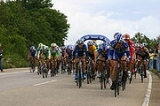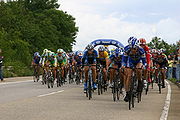
Peloton
Encyclopedia

Road bicycle racing
Road bicycle racing is a bicycle racing sport held on roads, using racing bicycles. The term "road racing" is usually applied to events where competing riders start simultaneously with the winner being the first to the line at the end of the course .Historically, the most...
. Riders in a group save energy
Energy
In physics, energy is an indirectly observed quantity. It is often understood as the ability a physical system has to do work on other physical systems...
by riding close (drafting
Drafting (racing)
Drafting or slipstreaming is a technique where two vehicles or other moving objects are caused to align in a close group reducing the overall effect of drag due to exploiting the lead object's slipstream...
or slipstream
Slipstream
A slipstream is a region behind a moving object in which a wake of fluid is moving at velocities comparable to the moving object . The term slipstream also applies to the similar region adjacent to an object with a fluid moving around it...
ing) near (particularly behind) other riders. The reduction in drag
Drag (physics)
In fluid dynamics, drag refers to forces which act on a solid object in the direction of the relative fluid flow velocity...
is dramatic; in the middle of a well-developed group it can be as much as 40%.
More loosely, "the peloton" can also refer to professional cyclists in general: "LeMond
Greg LeMond
Gregory James LeMond is a former professional road bicycle racer from the United States and a three-time winner of the Tour de France. He was born in Lakewood, California and raised in Reno, Nevada....
joined the European peloton at a time when few Americans could."
Riding in the peloton
The peloton travels as an integrated unit, like birdBird
Birds are feathered, winged, bipedal, endothermic , egg-laying, vertebrate animals. Around 10,000 living species and 188 families makes them the most speciose class of tetrapod vertebrates. They inhabit ecosystems across the globe, from the Arctic to the Antarctic. Extant birds range in size from...
s flying in formation, each rider making slight adjustments in response to the riders around him or her (particularly the one in front of each). When developed, riders at the front are exposed to higher loads, and will tend to slip off the front in order to rejoin the pack farther back. In some cases, with sufficient room to maneuver, this will develop into a fluid situation where the center of the peloton appears to be pushing through its own leading edge.
The shape or formation of the peloton changes according to many factors. A strong headwind or a hard effort tends to spread-out or string-out the riders, while a slow tempo or tailwind tends to bunch up the peloton into a wider formation. Side wind forces the peloton to form into echelons
Echelon formation
An echelon formation is a military formation in which members are arranged diagonally. Each member is stationed behind and to the right , or behind and to the left , of the member ahead...
in the direction of the wind. Often, the width of the road forces the peloton to form into several echelons. When two or more groups of riders want to contest control of the peloton, several lines may form racing one another.
While only the riders exposed to the wind at the front (and the windward side when there is a significant crosswind) of the peloton are the ones doing most of the work, it is usually advantageous to be positioned closer to the front of the peloton. One reason is to avoid being affected by the 'elastic band effect' in which a change in speed becomes amplified as it propagates to the back of the peloton. The rider riding behind a rider who is changing his/her speed must make the adjustment at a slightly faster rate (due to reaction time) to avoid collisions.
Moreover, being closer to the front means that the rider can react to attacks and changes in position with less effort. Gaps sometimes form in the peloton, and being closer to the front also reduces the risk of getting caught in the rear group when the peloton breaks form. Also, the risk of ending up in a crash declines when nearer to the front, because the frontmost riders have the fewest fallen riders to evade. Finally, being at the front of the peloton means dictating the tempo to some degree, and some teams or groups of riders may prefer different speeds as part of their tactics. Being at the front of the peloton is also advantageous when initiating a breakaway.
Tactical factors also apply. Teams generally attempt to cluster their members in the peloton in order to maximize their ability to affect the pack as a whole. For instance, if a team member is currently in a breakaway in front of the peloton, it is advantageous for the remaining members to slow the peloton as much as possible in an attempt to avoid catching the breakaway. This can be particularly effective in tight turns or narrow roads, where a single team can block the progress of the pack if they are in a favorable position. A similar situation occurs at the end of the race when teams will cluster in front of their sprinter, blocking the wind as long as possible while still leaving an open path in front for the sprinter to break out near the finish line.
It is typical for large hills to split up pelotons, as the aerodynamic factors are much less important at the slower climbing speeds, and power-to-weight ratio is the key determinant of speed.
External links
- Fortune: Pack Mentality, the energy economics of pelotons.
- WSJ: When the Middle of the Pack Is Good

